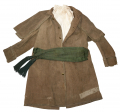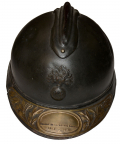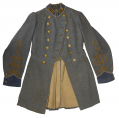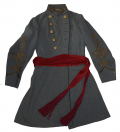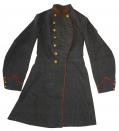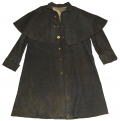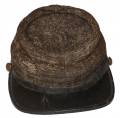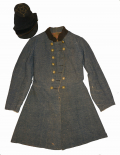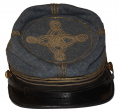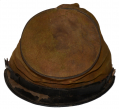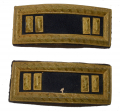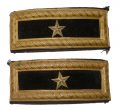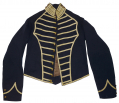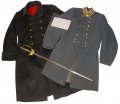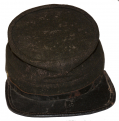site search
online catalog
Uniforms & Cloth
Showing 61 to 80 out of 224
A CONFEDERATE SURGEON'S GREATCOAT, SASH AND SHIRT
Dr. J. P. Rasser was contracted by the Confederacy and among his duties in Georgia was the examination of Conscripts for the Army. THE OVERCOAT or army great coat is certainly "Homespun" that is a… (1268-706). Learn More »
MORTON’S BATTERY FLAG OF FORREST’S CAVALRY: EX-GUNTHER COLLECTION, CHICAGO HISTORICAL SOCIETY, & TEXAS CIVIL WAR MUSEUM
This is one of two wartime Confederate flags flown by Capt. John W. Morton consecutively as guidons for his battery or simultaneously with one likely as the battery flag and the other as a personal or… (1286-621). Learn More »
WW1 FRENCH HELMET WITH VETERAN’S PLAQUE
A very clean example of the French M1915 Adrian helmet with very strong paint, comb and RF/bomb plate in place, as well as liner and chinstrap (detached on one end) and carrying an excellent example… (1202-705). Learn More »
WW1 ITALIAN HELMET, EX-JARRETT MUSEUM
A fine example of the Italian M1917 World War One helmet with original strong green paint and black painted Italian five-prong crown with the regimental number below. The comb is in place, as is the… (1202-696). Learn More »
$850.00
ON HOLD
CLOSE TO REGULATION VIRGINIA CONFEDERATE CAPTAIN'S FROCK COAT
The coat is made of mid- gray wool, possibly imported from England. It has full-length skirts ending in the typical and desirable raw edge. The sleeves have an 8 1/2-inch billow at the elbow. The dark… (1268-060). Learn More »
A SOUTH CAROLINA CONFEDERATE CAPTAIN'S SUPERB FROCK COAT
Worn by Robert Chisolm who formed Chisolm's Company, 1st Battalion South Carolina Sharpshooters on July 23,1862 after service in the artillery. This unit subsequently became Company A, 1st South… (1268-1006). Learn More »
A LOUISIANA CONFEDERATE ARTILLERY CAPTAIN'S FROCK COAT
This is an outstanding example that was until recently in the Fort Worth Texas Civil War Museum. The coat is double breasted and made of a dark gray wool satinet. There are seven Louisiana state… (1268-557). Learn More »
"HOMESPUN" CONFEDERATE SHELL JACKET - PVT WILLIAM B. MARSHALL, 2ND LOUISIANA CAVALRY
Private/trooper William B. Marshall trooper 2nd Louisiana cavalry wore this jacket until his death in a Union prison. Prior to it being in the Texas Civil War Museum it was the property of the author… (1268-367). Learn More »
A RARELY SEEN CONFEDERATE INFANTRYMAN'S GREATCOAT
Once in the famed museum collection of Ray Richey, this Confederate mid-gray infantry overcoat or greatcoat is all original and in very good condition all things considered. The hand sewn overcoat is… (1268-043). Learn More »
CONFEDERATE SURGEON'S KEPI FOUND IN SOUTH CAROLINA
This cap was discovered in a Civil War period home in Charleston SC near "The Battery" neighborhood not many years ago. When found the cap needed a few minor repairs but it otherwise remains untouched… (1130-09). Learn More »
A FINE EXAMPLE OF A CONFEDERATE INFANTRYMAN'S KEPI
This cap's crown, top and base band are made from a medium weight open weave woolen fabric which may be a blend of sorts. It certainly looks "home spun". The kepi gives indications of being a depot… (1268-037). Learn More »
A BEYOND RARE CS ARKANSAS FROCK COAT AND "BONNET DE POLICE"
Mr. Ray Richey, owner of the Texas Civil War Museum, purchased this uniform coat and hat directly from an Arkansas estate in 2003. Twenty-six years prior to this it was acquired from the Beneux… (1268-057). Learn More »
MAJOR TO GENERAL'S CAP OF ROBERT F. HOKE
This superb kepi was previously owned by well-respected individuals including Mr. Richard Abel, Mr. Shannon Pritchard and Mr. Ray Richey owner and operator of the Texas Civil War Museum. We have the… (1268-1010). Learn More »
$35,000.00
SOLD
A FORAGE CAP THAT "WHISTLES DIXIE"
This coffee-colored wool forage cap was discovered in Morristown, Tennessee in 1964 by a Mr. Robert Walter. Based on the pre-war model 1858 cap it certainly is a wool and cotton blend and measures 3… (1268-554). Learn More »
NICELY MARKED SMITH PATENT CAPTAIN OF STAFF SHOULDER STRAPS
A very good condition and good looking set of Smith Patent shoulder straps for a Captain on staff duty. There were at least a couple of patents during the Civil War for some form of metallic border in… (490-7268). Learn More »
CIVIL WAR BRIGADIER GENERAL SMITH PATENT SHOULDER STRAPS
An excellent condition set of Smith Patent shoulder straps for a Brigadier General. James Smith’s patent used stamped and gilded brass metallic frames to imitate the bullion embroidered borders of… (490-7265). Learn More »
ID’D P1855 MOUNTED SERVICES MUSICIAN’S SHELL JACKET – WILLIAM OSWALD, 4th PENNSYLVANIA CAVALRY
William Oswald resided in Northampton County, Pennsylvania when he enlisted on August 15th, 1861. On that same day, he mustered into Company “A” of the 4th Pennsylvania Cavalry as a Bugler. … (1268-776). Learn More »
$8,500.00
SOLD
ZOUAVE FIRST SERGEANT CHEVRONS
These chevrons measure about 8 inches wide and 4 inches tall and use a red ground with three narrow, sewn, medium blue stripes and a diamond/lozenge, indicating a First Sergeant, the senior… (490-7153). Learn More »
THE HISTORICALLY SIGNIFICANT UNIFORM AND SWORD GROUPING OF BRIGADIER GENERAL EPPA HUNTON CSA
Eppa Hunton was born near Warrenton, Virginia on September 24, 1822. After graduating from the New Baltimore Academy, he taught school for three years, then studied law and was admitted to the bar in… (2025-295). Learn More »
$135,000.00
ON HOLD
CONFEDERATE DEEP SOUTH DEPOT ENLISTEDMAN'S KEPI
Federal soldier George Wilson, 21st Missouri Infantry (US), captured this cap at the Fort Blakely fight near Mobile, Alabama April 9th, 1865. The cap appears to have been mass produced at a clothing… (2025-300). Learn More »
$16,500.00
ON HOLD
Showing 61 to 80 out of 224
Most Popular
Historical Firearms Stolen From The National Civil War Museum In Harrisburg, Pa »
Theft From Gravesite Of Gen. John Reynolds »
Selection Of Unframed Prints By Don Troiani »
Fine Condition Brass Infantry Bugle Insignia »
Large English Bowie Knife With Sheath 1870’S – 1880’S »
Imported (Clauberg) Us Model 1860 Light Cavalry Officer's Saber »
featured item
EXCELLENT CONDITION EARLY MARINE MAMALUKE WITH IVORY GRIP AND ENGRAVED SCABBARD
Manufactured: U.S. Maker: Unmarked Year: C1820-25 Model: Mamaluke Size: 29.25 inch blade 1.30 in. wide Condition: Excellent+ Sharply curved, single edged, blue and gold engraved blade decorated with ships mast, Indian with headdress, arms,… (870-72). Learn More »



